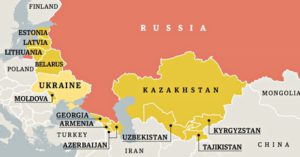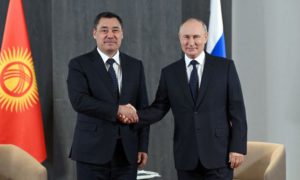Unmasking Russia’s Influence and Situation Within the Commonwealth of Independent States
Understandably, the global heat is seriously influencing the former Soviet republics, the backyard of the Russian Federation. These republics have attained their independence since 1991 after Soviet’s collapse and consequently have the unique opportunity to choose their own political and economic directions. But that has not been the case, as Russia casts its political shadow in order to control, at least to some degree, Western and European presence in the central Soviet-Asian region.

Across the Central Asian region, Russia has not been at ease especially with the recent developments between Armenia and Azerbaijan. And it is no secret that Kazakhstan has embarked on several initiatives to diversify its economy, adopting western-oriented models of management and development.
Since the Russia-Ukraine crisis began, those Central Asian republics have kept their neutral position and are pursuing their own geopolitics without much ties to the dictates of Moscow. Kazakhstan has welcomed tens of thousands of Russians fleeing from the military call-up (mobilization) since last year.
In September 2022, Kazakhstan even vowed to comply with the massive Western sanctions on Russia, with its leader saying Astana will not help Moscow circumvent them. Central Asian countries, which have many citizens working in Russia, have warned their people not to fight in Ukraine alongside Moscow’s forces.
The Kazakh leader has also welcomed United States efforts to expand cooperation in the C5+1 format (Kazakhstan, Kyrgyzstan, Tajikistan, Turkmenistan, Uzbekistan and the United States), noting the importance of the Astana meeting of Central Asian and US foreign policy leaders.
In pursuit of building a regional group, Russia has been making efforts to improve multifaceted relations with these Central Asian republics, for example, under the umbrella of Eurasian Union. By the stipulated guidelines, Russia and Kyrgyzstan are members, consequently both have to share common aspirations and common future. The Commonwealth of Independent States (CIS) still exist in theory, as in one way or the other, the Soviet republics have political differences.
At this new stage of political developments around the world, Russia deems it necessary to balance its geopolitical interest and bilateral relations with Kyrgyzstan, especially broadening economic perspectives, and maintaining long-term security aspects in their bilateral relations in the region.
Following the sketchy review from above, on October 12 to 13, President Vladimir Putin went on an official working visit to Kyrgyzstan. The key reason was to discuss further development of Russian-Kyrgyz relations of strategic partnership and alliance in various areas, including with regard to Kyrgyzstan’s chairmanship of the CIS this year and Russia’s chairmanship of the Eurasian Economic Union.
On October 13, the President took part in a meeting of the CIS Heads of State Council. Kyrgyzstan hosted the Commonwealth of Independent States summit, and in attendance were leaders of Azerbaijan, Belarus, Kazakhstan, Tajikistan, Turkmenistan and Uzbekistan.
The CIS leaders reviewed the interaction within the organization in 2023, outlined the main areas for future activity, and exchanged opinions on current international and regional issues. Putin briefed his colleagues on the priorities of Russia’s chairmanship of the CIS in 2024.
A package of documents aimed at further developing cooperation between the CIS states in the economic, cultural, humanitarian and law enforcement areas were signed following their extensive meeting.
As already mentioned due to the conflicts between Armenia and Azerbaijan, Armenian Prime Minister Nikol Pashinyan skipped the summit. As we know from this historical development, Yerevan’s relationship with Moscow has frayed amid mutual accusations. His snub came after Armenian lawmakers moved to join the ICC, angering Moscow and potentially limiting Putin’s travel options further.
Pashinyan has criticized Moscow for not intervening when Azerbaijan launched a successful offensive to take over the breakaway Nagorno-Karabakh region in September 2023. Nagorno-Karabakh is a region located in the South Caucasus, covering the southeastern stretch of the Caucasus mountain range. Part of the greater region of Karabakh, it spans the area between Lower Karabakh and Syunik.
Ahead of Putin’s trip, Kyrgyzstan said it had ratified an agreement for a common air defence system with Russia. Moscow has similar deals with other allied countries including Kazakhstan, Belarus and Tajikistan.
“We are gathered here to solemnly mark a very significant anniversary: the 20th anniversary of the establishment of a Russian joint military airbase in the city of Kant in the Kyrgyz Republic. This is an important milestone for our Kyrgyz friends and us in cooperation in the area of defense and strengthening regional security as a whole,” Putin said.
Putin held bilateral meetings with Kyrgyz counterpart Sadyr Japarov and with his Belarus ally Alexander Lukashenko and other regional leaders. Putin also had a special meeting with President of the Republic of Azerbaijan Ilham Aliyev.

The Azerbaijani side was represented by Deputy Prime Minister Shahin Mustafayev, Foreign Minister Jeyhun Bayramov, Presidential Aide Hikmet Hajiyev, Defence Minister Zakir Hasanov, and Economic Minister Mikayil Jabbarov.
Putin’s meeting with President of Tajikistan Emomali Rahmon, on the sidelines of the CIS Heads of State summit in Bishkek, centered specifically on security problems in the region. Russia is an important strategic partner and ally of Tajikistan.
There is dynamism to collaboration between them in all other areas. Just similar to most of Putin’s meetings with other leaders were focused on security and economic agenda.
Of course, the number one issue is the situation in Nagorno-Karabakh, and then discussed extensively structuring bilateral cooperation. In addition, both have concretely described the results as very impressive in terms of trade, industrial cooperation, and cooperation in the transport sector: there are a lot of new projects, and those involving regional and security issues.
There are further takeaways from the summit. The establishment of Russian air defence to be placed in Kyrgyzstan, which borders Peoples Republic of China (PRC). We cannot overstate the importance of creating a Russian-Kyrgyz joint air defence system, which will be located in Kyrgyzstan. But a quotation from Kremlin Spokesman Dmitry Peskov does the trick:
“This is a joint air defence system. It is a great achievement for Russia and Kyrgyzstan. It is very important, given that Russia and Kyrgyzstan, in addition to allied relations, are still included in many joint integration associations. Of course, such common elements of security are very important.”
On October 11, the Kyrgyz parliament ratified an agreement with Russia on the creation of a joint regional air defence system. The deputies of the Zhogorku Kengesh (Kyrgyz parliament) adopted in three readings a bill on the agreement to create a joint regional air defence system with Russia.
The agreement between the parties was signed in August 2022. In May, Russian President Vladimir Putin signed a law on its ratification. The agreement between Russia and Kyrgyzstan will be valid for five years with further extension.
According to the agreement, the Russian side will coordinate the joint actions of the air defence forces, while Kyrgyzstan will be responsible for managing the joint actions of the air defence system troops in the collective security area.
A land plot of five hectares was provided for the air defence system near the Russian air base in the city of Kant. Russia has several military facilities in Kyrgyzstan. The largest of them is the air force base in Kant, which has existed since 2003. Russia annually pays Kyrgyzstan almost US$4.8 million for the lease of 58 hectares of land.
In terms of trade, Russia and Kyrgyzstan have targeted the current aspects of bilateral and multilateral cooperation between them, as they are strategic partners. Both reaffirmed strong commitment to stimulating and expanding bilateral cooperation. Evidence of this is the bilateral documents both have signed, and formally agreed to take measures to increase mutual trade and to strive for the ambitious target of US$5 billion.
Furthermore, the two parties expressed deep satisfaction with the positive results of the 10th Kyrgyzstan-Russia Interregional Conference on Industrial Cooperation. The conference led to the signing of documents and contracts exceeding US$3.5 billion.
Russia is the biggest investor in the Kyrgyz economy. One third of all direct foreign investment in the country comes from Russia. There are some 800 Russian-Kyrgyz enterprises engaged in such key sectors as energy, mining, machine-building, agriculture and transport that are successfully operating in the republic.
An important landmark was the 30 years of the Kyrgyz-Russian Slavic University. This anniversary once again emphasizes the multi-dimensional nature of the Russia-Kyrgyzstan partnership that extends to many areas, including cultural and humanitarian affairs.
It was highly noted the role of the Kyrgyz-Russian Slavic University, which has become one of the leaders in higher education and science in Kyrgyzstan over the past 30 years. Since its inception, the university has produced a large number of highly qualified specialists now working in Kyrgyzstan, Russia and other countries.
One more ceremony was the presentation of a high state award of the Russian Federation, the Order of Honour, to the President of the Kyrgyz Republic Sadyr Japarov. Putin pointed to his commitment as a supporter of consistently advancing Eurasian integration and strengthening the atmosphere of partnership, trust and cooperation in the region.
As expected, Kyrgyz Republic Sadyr Japarov considered this award as recognition of the high level of Russia-Kyrgyzstan relations. Japarov expressed the desire to develop integration potential within the CIS, the CSTO and the EAEU.
Putin answered the Russian media’s questions following his official two-day visit to the Kyrgyz Republic and CIS summit events. In the sum up, he pointed to some detailed post-Soviet historical developments that existed among the former Soviet republics, and the evolving complicated trends now.
“As for the territory of Karabakh now, Armenia recognised that Nagorno-Karabakh is part of the Republic of Azerbaijan,” he said during the media conference. On the other hand, the Armenian side insisted on scheduling the date for the referendum and determining the status of Nagorno-Karabakh in that way.
They also proceeded from the fact that even if the referendum is held in 20 years, with the current composition of the population, the result will be obvious.
Following the Russo-Georgian War in 2008 and Russia’s initial invasion of Ukraine in 2014, Ukraine and Georgia withdrew. Moldova has also begun the process of leaving the organization. There is also the Eurasian Union which consists of five members (Armenia, Belarus, Kazakhstan, Kyrgyzstan and Russia).
The CIS summit was to a large degree a success, despite the challenges and some disagreements among the republics with Russia. The CIS was originally formulated in 1991 as an informal successor organization for the former constituent republics of the Soviet Union. However, only Armenia, Azerbaijan, Belarus, Kazakhstan, Kyrgyzstan, Moldova, Tajikistan, Russia and Uzbekistan are current members.
While the full-scale Ukraine offensive made Putin a persona-non-grata in the Western world, the International Criminal Court (ICC) ruling virtually closed the door to a large part of the globe for him. The Rome Statute, a treaty requiring members to adhere to ICC rulings, has been ratified by 123 countries.
Putin visited all five regional countries — Uzbekistan, Kazakhstan, Tajikistan, Turkmenistan and Kyrgyzstan — in 2022, portraying them as Russia’s core allies.
But since Jan. 2023, Putin has travelled only to Russian-occupied parts of Ukraine, with his last foreign trips to Belarus and Kyrgyzstan in December 2022 — a far cry from the busy international schedule he had in previous years as president. Now, in a sign of Russia’s isolation, he plans a visit to North Korea next, as well as China.
Author: Kester Klomegah
yogaesoteric
November 13, 2023
